- Decay of Antibiotic Resistance Genes in Surface Waters
- Resistance of Bacteria Indigenous to Wastewater to Disinfection
- FloodNet: Real-time, Hyperlocal Street-level Flood Monitoring
- Impact of Flooding on the Microbiome of Urban Surfaces
- Modeling Sunlight Disinfection of Waterborne Bacteria and Viruses
- Design Guidelines for Shallow, Open-water Wetlands
- COVID-19 Wastewater-based Epidemiology: Monitoring Wastewater for SARS-CoV-2
Decay of Antibiotic Resistance Genes in Surface Waters
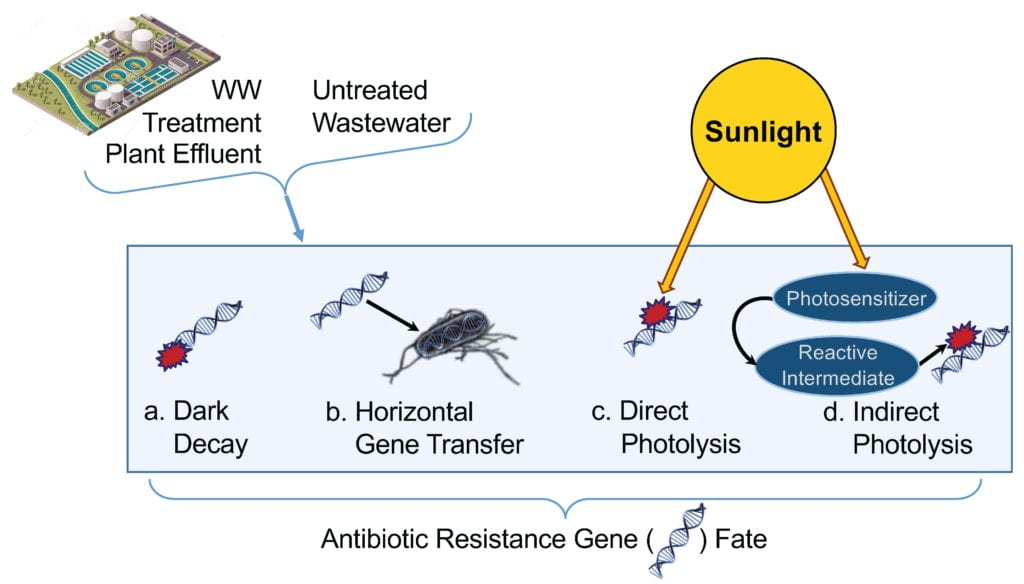
Sewage contains an abundance of antibiotic resistance genes (ARG; i.e., the bacterial genes that encode for resistance to antibiotics) and antibiotic resistant bacteria (ARB), making wastewater treatment facilities strategic control points for reducing their transmission. Many conventional treatment processes, however, are not able to degrade ARG, which results in the discharge of intact ARG to the environment where they may spread to new viable bacteria via horizontal gene transfer. Despite the importance of the aquatic environment as a route of ARG transmission, there have been no controlled studies of ARG fate in surface waters. We are working to fill this critical knowledge gap by (1) evaluating the rates and mechanisms of ARG decay in the aquatic environment with a focus on sunlight degradation processes, and (2) developing broadly applicable numerical models that can predict photolysis rates of ARG under a range of environmental conditions.
Supported by the United States National Science Foundation. (Image: Sunlight photolysis mechanisms for DNA)
Resistance of Bacteria Indigenous to Wastewater to Disinfection
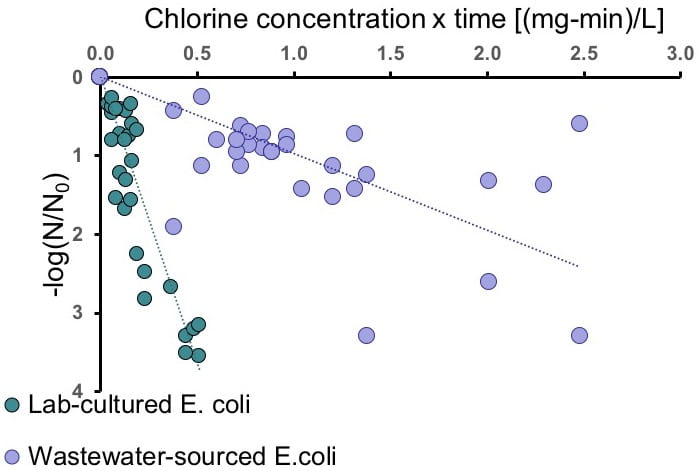
Bacteria found in wastewater and environmental waters have been found to have greater resistance to commonly used disinfectants than laboratory-cultured organisms of the same species. Through targeted experiments utilizing culture-based and molecular assays, we are working to determine the extent and mechanisms of bacterial resistance to sunlight, chlorine, chloramines, and ultraviolet radiation.
(Image: Chlorine disinfection kinetics of laboratory-cultured and wastewater-sourced E. coli. Figure credit: Mwanarusi Mwatondo)
FloodNet: Real-time, Hyperlocal Street-level Flood Monitoring
In collaboration with Dr. Charlie Mydlarz, Prof. Elizabeth Henaff, and Prof. Tega Brain at NYU, Prof. Brett Branco at CUNY Brooklyn College and the Science and Resilience Institute at Jamaica Bay, and Prof. Ricardo Toledo-Crow at CUNY Advanced Science Research Center
 .
. 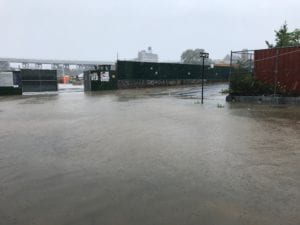
Of the myriad impacts that are predicted to accompany climate change, flooding is expected to have an outsized influence on public health, infrastructure, and mobility in urban areas. Sea level rise and an increase in the occurrence of high intensity rain storms (which convey large volumes of water to drains, leading to backups and overflows) can lead to a dramatic increase in flood risk, particularly in low-lying and coastal neighborhoods. There is anecdotal evidence of an increased occurrence of street-level flooding in New York City, however there is no systematic collection of data that can be used to document floods or design mitigation strategies. Therefore, the goals of this work are to design and deploy a network of low-cost flood level sensors to quantitatively track and evaluate hyperlocal urban flooding in New York City, including a public-facing data dashboard to serve a wide range of community, municipal, and academic stakeholders. The project involves partnerships with the CUNY Advanced Science Research Center, the NYC Department of Environmental Protection, the NYC Mayor’s Office of Climate and Environmental Justice, the NYC Mayor’s Office of Technology and Innovation, and local community advocacy groups.
More information can be found on the FloodNet website and the project’s GitHub page. Real-time and historic data can be found on the FloodNet data dashboard.
Supported by the NYC Department of Environmental Protection, the Alfred P. Sloan Foundation, C2SMART Transportation Research Center, and New York Empire State Development Smart Cities Partnership. (Image: Flood level sensor. Image credit: Charlie Mydlarz)
Impact of Flooding on the Microbiome of Urban Surfaces
In collaboration with Prof. Elizabeth Henaff and Prof. Tega Brain.
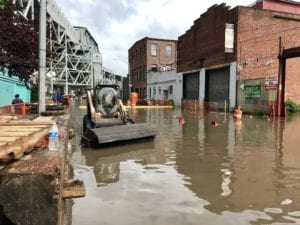
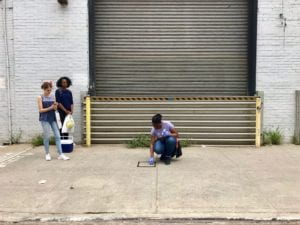
Urban flood water contains a diverse array of contaminants, including industrial and household chemicals, fuels and sewage found in an urban environment. Given that all environmental surfaces support microbial communities whose diversity and identities reflect on the history of that environment, disruptions can impact a community profile in ways that reflect the disruption itself. The goals of this work is to evaluate how sewage-influenced flood waters impact the microbial community of urban surfaces (e.g., sidewalk, soil, walls or floors of homes) and investigate the ways in which the resulting microbial fingerprint evolves over time after a flood event.
Supported by the NYU Marron Institute. (Images: Street-level flooding in the Gowanus neighborhood of Brooklyn, and sidewalk swabbing in the same location. Image credit: Andrea Silverman)
Modeling Sunlight Disinfection of Waterborne Bacteria and Viruses
Natural wastewater treatment systems, including wastewater treatment ponds and constructed wetlands, are used globally for treatment of domestic sewage and polishing of wastewater treatment plant effluent. In removing and transforming nutrients, chemical contaminants and waterborne pathogens, these systems play an important role in protecting public and environmental health. Sunlight disinfection is the dominant mode of inactivation of viruses and bacteria in these systems, and has additional important and far-reaching applications, including microbial ecology of sunlit surface waters, recreational water quality, and the fate of microbial fecal markers in the environment. The goals of this work are to determine the mechanisms and rates of inactivation of human viruses, bacteriophages, and bacteria in natural waters and wastewater, and develop new modeling approaches to predict sunlight inactivation rates. Improved inactivation rate models can be used as tools for optimizing the design of natural wastewater treatment systems to promote disinfection and meet health-related treatment objectives.
Design Guidelines for Shallow, Open-water Wetlands
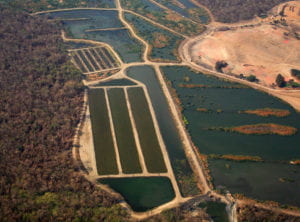
Shallow, open-water wetlands are treatment wetlands designed to promote photo-mediated and biological water treatment processes. These processes include photolysis and biotransformation of chemical contaminants, photoinactivation of waterborne pathogens, and biological removal of nitrate (e.g., denitrification). Open-water wetlands outperform vegetated wetlands with respect to removal of nitrate, microbial contaminants, and trace organic compounds. Given their improved treatment efficiency, open-water wetlands are attractive options for the polishing of municipal wastewater effluent, treatment of water in effluent-dominated waterways, or use as the final stage of wastewater treatment pond systems that receive municipal wastewater. The Open-water Wetland Guidelines are targeted towards those that design, build, and operate natural treatment systems, and present recommendations and equations for the design and operation of these systems.
The guidance document for determining decay rates of select trace organic contaminants, nitrate, E. coli and bacteriophage MS2 can be found here: https://www.liebertpub.com/doi/abs/10.1089/ees.2018.0177
(Image: Shallow, open-water wetland cells at the Prado Wetlands in Orange County, CA. Image credit: Scott Nygren)
COVID-19 Wastewater-based Epidemiology: Monitoring Wastewater for SARS-CoV-2
SARS-CoV-2, the virus that causes COVID-19, is excreted in high numbers in the feces of infected individuals, and has been detected in wastewater entering centralized treatment facilities. This finding has presented an opportunity to monitor wastewater to detect trends in COVID-19 disease prevalence at the community scale. This work is a partnership with the NYC Department of Environmental Protection, Queens College, and Queensborough Community College to conduct research and development for implementation and optimization of an ongoing sewage monitoring program for SARS-CoV-2 in New York City. The NYC DEP is collecting bi-weekly samples from New York City’s 14 wastewater treatment facilities for quantification of SARS-CoV-2; the data is shared with the NYC DOHMH for incorporation in COVID-19 surveillance activities.
Additional work, in collaboration with researchers involved with the CoSeS project, involves interfacing with departments of public health around the United States to understand the opportunities, challenges, and limitations to using wastewater monitoring data to inform public health decision-making. One outcome was a collaboration with the US Centers for Disease Control and Prevention National to help draft considerations for implementation of wastewater-based disease surveillance systems (published on the CDC National Wastewater Surveillance System website)
Supported by the Alfred P. Sloan Foundation and the NYC Department of Environmental Protection.